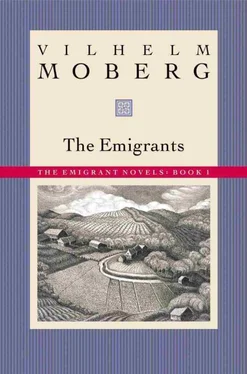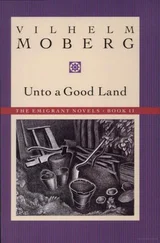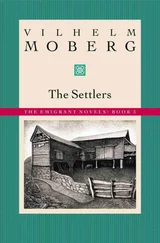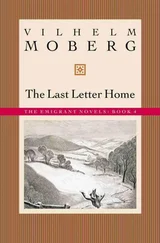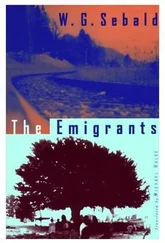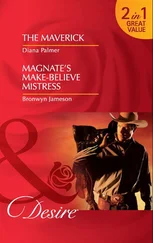Vilhelm Moberg - The Emigrants
Здесь есть возможность читать онлайн «Vilhelm Moberg - The Emigrants» весь текст электронной книги совершенно бесплатно (целиком полную версию без сокращений). В некоторых случаях можно слушать аудио, скачать через торрент в формате fb2 и присутствует краткое содержание. Год выпуска: 1995, Издательство: Minnesota Historical Society Press, Жанр: Классическая проза, на английском языке. Описание произведения, (предисловие) а так же отзывы посетителей доступны на портале библиотеки ЛибКат.
- Название:The Emigrants
- Автор:
- Издательство:Minnesota Historical Society Press
- Жанр:
- Год:1995
- ISBN:нет данных
- Рейтинг книги:3 / 5. Голосов: 1
-
Избранное:Добавить в избранное
- Отзывы:
-
Ваша оценка:
- 60
- 1
- 2
- 3
- 4
- 5
The Emigrants: краткое содержание, описание и аннотация
Предлагаем к чтению аннотацию, описание, краткое содержание или предисловие (зависит от того, что написал сам автор книги «The Emigrants»). Если вы не нашли необходимую информацию о книге — напишите в комментариях, мы постараемся отыскать её.
The Emigrants — читать онлайн бесплатно полную книгу (весь текст) целиком
Ниже представлен текст книги, разбитый по страницам. Система сохранения места последней прочитанной страницы, позволяет с удобством читать онлайн бесплатно книгу «The Emigrants», без необходимости каждый раз заново искать на чём Вы остановились. Поставьте закладку, и сможете в любой момент перейти на страницу, на которой закончили чтение.
Интервал:
Закладка:
The third group included people who only temporarily needed help. They received alms from a special fund known as the Ljuder Parish Poor Purse, under the supervision of the parish council. This last group included also “profligate and lazy people who had themselves caused their poverty.” They, according to the council’s decision, “should be remembered with the smallest aid from the Poor Purse, thereby getting accustomed to sobriety and industry.”
Destitute orphans were auctioned off by the parish council to “suitable homes at best bid.” For these “parish boys” and “parish girls” the council sought to find foster homes where the children would receive “fatherly care and in good time instruction in honest habits and work.”
Conditions were similar in other parishes in Sweden at that time.
The Spiritual Care of the Inhabitants
The people were fostered in the pure evangelical-Lutheran religion in accordance with the church law of 1686, and were protected from heretical and dangerous new ideas by the royal “Resolution and Order” of January 12, 1726, “this wholesome Resolution aiming at good order in the parish, and Christian unity in teaching.”
In the church law the clergy were admonished to “see to it that the children learn to read so that they may with their own eyes see God’s holy laws and commands.” This instruction in reading, advisable only for salvation of the soul, was administered by schoolmaster or by parents. Each fall the minister held an examination in the tenets of the faith according to the Little Catechism of Luther. All unmarried parishioners at this time were probed concerning their reading ability, and were fined for failure to attend.
The parish in 1836 engaged its own schoolmaster, Rinaldo, an ex-enlisted cavalry soldier who, having lost an eye, had been permitted to leave the military service. The schoolmaster received a yearly fee of twelve bushels of rye, and one shilling (half a cent) per day for each child he taught. The parents gave him room and firewood besides. Rinaldo wandered from one end of the parish to the other, and held his school in the homes of the peasants, who each in turn allowed him the use of some spare room or attic for this purpose. The length of the term in each house was decided by the schoolmaster. He had been engaged to teach the children to read well enough to learn Luther’s Little Catechism by heart. He ventured sometimes to include such worldly and useless subjects as arithmetic, writing, Swedish history, and geography. Most men and women could read fairly well; some could sign their names; few could write more than this, and very few of the women could write at all: no one knew what use a female could make of the art of writing.
Religious Sects
The so-called Åkian heresy had started in the neighboring parish of Elmeboda about 1780, and soon spread also to Ljuder. The adherents to the sect were called Åkians after the founder, Åke Svensson of Östergöhl, Elmeboda. They tried to copy the early Christian church and return to the ways of the apostles. The Åkians separated from the state church and recognized neither temporal nor spiritual powers in their community. All differences between people as to caste or property ownership were to them contrary to God’s word, and so within their own sect they lived a completely communal life. None of them called a single object his own. They conducted their own services and held their own Holy Communion.
Some forty persons in Elmeboda and Ljuder Parishes had joined the new sect. Many of them belonged to Åke Svensson’s family, which was scattered throughout both parishes. The home of the sect in Ljuder was Kärragärde, owned by Åke’s brother-in-law Andreas Månsson.
The Åkians were soon called in for questioning by the bishopric of Växiö and were given strong warnings. But they were inflexible and met the dignitaries of the church with unpropitious words. The church pronounced its ban but the Åkians retained their convictions. They were then sued in civil court and were brought to Konga County Court in Ingelstad, 1where the court admonished them to abide by the law and follow the regulations of the established church. Åke Svensson and his followers could not be persuaded to recant their heretical opinions; they refused to return to the fold of the only true church.
In order to maintain church peace and civil security the case was reviewed by the Göta Crown Court. 2This court found the members of the sect “completely fallen into insanity, having lost the use of their sound minds,” and held that, to maintain peace, and for the welfare of the dissenters, they should be confined in an asylum. Åke Svensson and seven other leaders of the sect “who had shown their insanity in many instances” were ordered transported to Danvik’s asylum in Stockholm, “there to receive such attention as their condition warranted.”
The eight sectarians who had fallen under the Crown Court’s order were turned over to the sheriff. In 1786 they were taken to Danvik’s asylum in Stockholm. Åke Svensson, Andreas Månsson, and two others died within two years, after having received “the attention their condition warranted.” Åke was at the time of his death thirty-five years of age.
The other dissenters were gradually liberated and returned as cured to their respective homes, where the one-time asylum inmates lived tranquilly and harmoniously, and for many years it seemed as if the firebrand of Åkianism was for ever smothered. But in the eighteen-forties this dangerous heresy reappeared in Ljuder Parish. The circumstances, however, belong to the story.
V. M.
NOTES
1. Konga County Records for 1785.
2. Gota Crown Court Proceedings, December 12, 1785.
Part One. Gates on the Road to America
I. KING IN HIS STONE KINGDOM
— 1—
Mjödahult is one of Ljuder’s most ancient homesteads. Its name is mentioned in a court record two hundred years before the discovery of America.
The Nilsa family had tilled and lived on this farm as far back in history as paper is preserved, as far as the memory of generations can reach. The first known owner was Nils in Mjödahult after whom the family got its name. About Nils in Mjödahult it is further known that he had an unusually large and grotesque nose, which was said to have resembled a well-grown rutabaga. This nose was inherited by his descendants, and someone in each generation possessed it. It became a mark of the Nilsa family. Called the Nilsa-nose, it was believed to be endowed with the same magic powers as a birth cowl, and brought luck to its owner. Children born with the Nilsa-nose became the most fortunate and most successful members of the family, and, even though it was hardly a mark of beauty in a woman, it is not known to have been an obstacle in securing advantageous marriages.
The assessment book indicates that Nils’ Mjödahult was still a full homestead in the eighteenth century. The farm was later split up several times, lastly in 1819 when two brothers, Olov Jakob’s Son and Nils Jakob’s Son, received equal shares. The records list four more brothers and three sisters. The new farms were by now only one-sixteenth of the original homestead. Nils, the younger brother, obtained the split-off piece: three arable acres on the outskirts, where he built his house among the straggling pines. The new farm is recorded as “one-sixteenth crown assessment Korpamoen under the mother homestead Mjödahult.”
Nils Jakob’s Son was short of build — only five feet — and he had not been endowed with the Nilsa-nose. He was nevertheless a capable man, strong-armed and persevering; his hands did not willingly rest if there was aught to do. Märta, his wife, was a strong and stately woman, a full head taller than her husband.
Читать дальшеИнтервал:
Закладка:
Похожие книги на «The Emigrants»
Представляем Вашему вниманию похожие книги на «The Emigrants» списком для выбора. Мы отобрали схожую по названию и смыслу литературу в надежде предоставить читателям больше вариантов отыскать новые, интересные, ещё непрочитанные произведения.
Обсуждение, отзывы о книге «The Emigrants» и просто собственные мнения читателей. Оставьте ваши комментарии, напишите, что Вы думаете о произведении, его смысле или главных героях. Укажите что конкретно понравилось, а что нет, и почему Вы так считаете.
